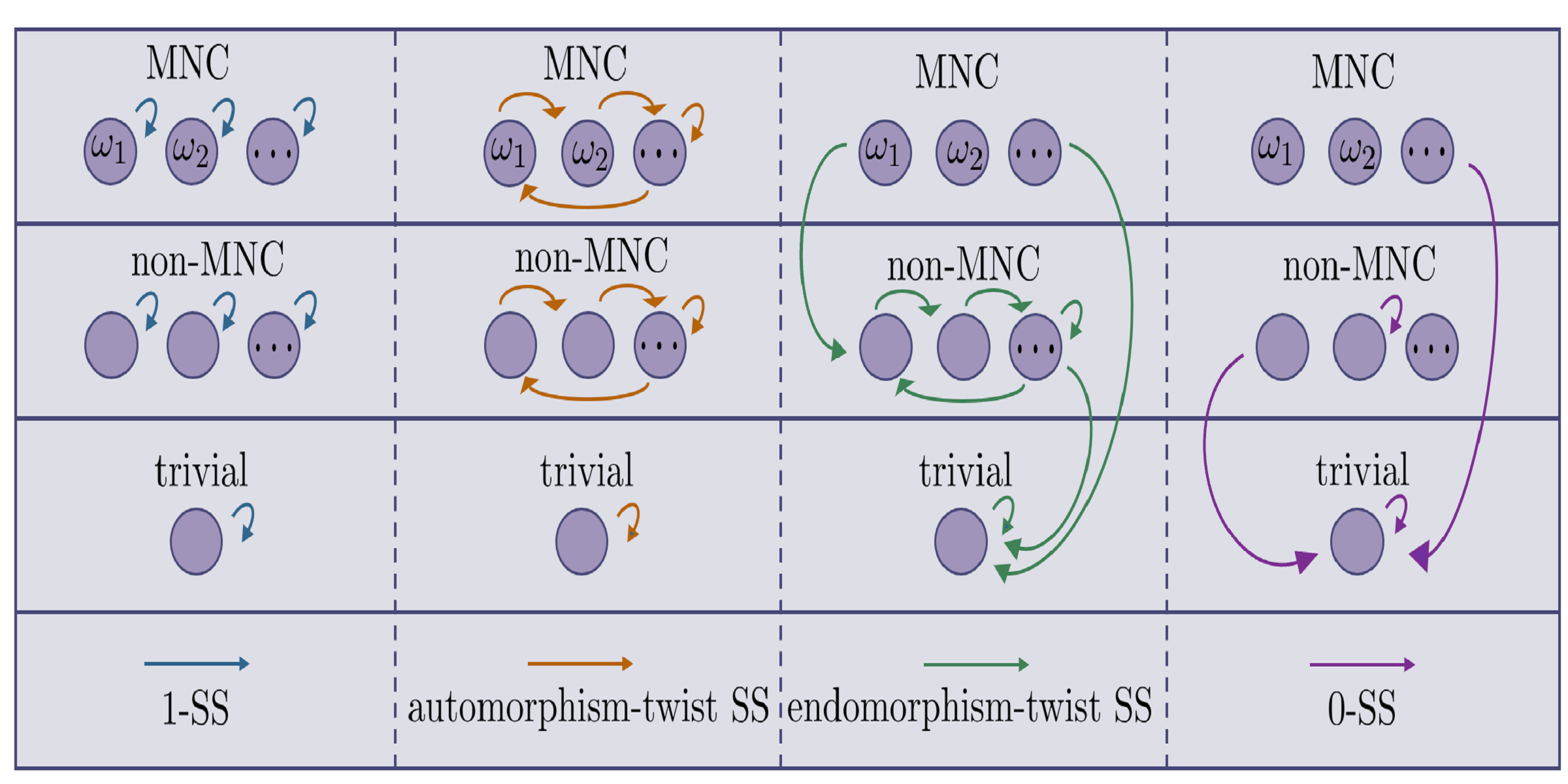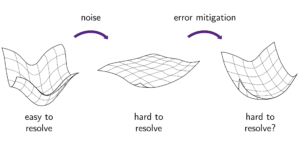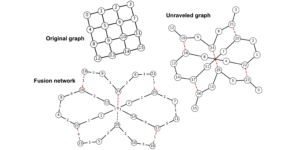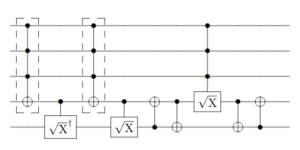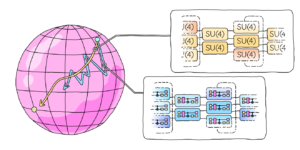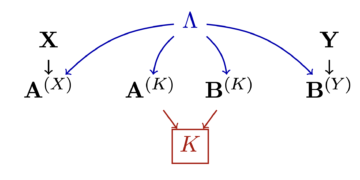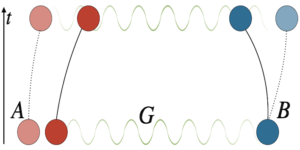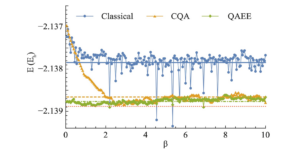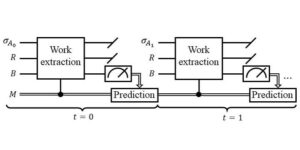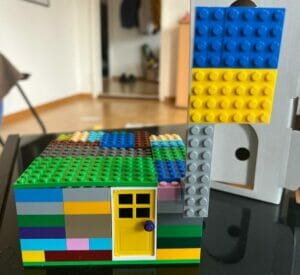1Max-Planck-Institut für Quantenoptik, Hans-Kopfermann-Straße 1, 85748 Garching, Németország
2Müncheni Kvantumtudományi és Technológiai Központ, Schellingstraße 4, 80799 München, Németország
3Bécsi Egyetem, Matematikai Kar, Oskar-Morgenstern-Platz 1, 1090 Wien, Ausztria
4Bécsi Egyetem, Fizikai Kar, Boltzmanngasse 5, 1090 Wien, Ausztria
Érdekesnek találja ezt a cikket, vagy szeretne megvitatni? Scite vagy hagyjon megjegyzést a SciRate-en.
Absztrakt
We systematically investigate the robustness of symmetry protected topological (SPT) order in open quantum systems by studying the evolution of string order parameters and other probes under noisy channels. We find that one-dimensional SPT order is robust against noisy couplings to the environment that satisfy a strong symmetry condition, while it is destabilized by noise that satisfies only a weak symmetry condition, which generalizes the notion of symmetry for closed systems. We also discuss “transmutation” of SPT phases into other SPT phases of equal or lesser complexity, under noisy channels that satisfy twisted versions of the strong symmetry condition.
► BibTeX adatok
► Referenciák
[1] F.D.M. Haldane. “Continuum dynamics of the 1-d heisenberg antiferromagnet: Identification with the $o(3)$ nonlinear sigma model”. Physics Letters A 93, 464–468 (1983).
https://doi.org/10.1016/0375-9601(83)90631-X
[2] F. D. M. Haldane. “Nonlinear field theory of large-spin heisenberg antiferromagnets: Semiclassically quantized solitons of the one-dimensional easy-axis néel state”. Phys. Rev. Lett. 50, 1153–1156 (1983).
https:///doi.org/10.1103/PhysRevLett.50.1153
[3] Ian Affleck, Tom Kennedy, Elliott H. Lieb, and Hal Tasaki. “Rigorous results on valence-bond ground states in antiferromagnets”. Phys. Rev. Lett. 59, 799–802 (1987).
https:///doi.org/10.1103/PhysRevLett.59.799
[4] Marcel den Nijs and Koos Rommelse. “Preroughening transitions in crystal surfaces and valence-bond phases in quantum spin chains”. Phys. Rev. B 40, 4709–4734 (1989).
https:///doi.org/10.1103/PhysRevB.40.4709
[5] Tom Kennedy and Hal Tasaki. “Hidden $mathbb{Z}_2timesmathbb{Z}_2$ symmetry breaking in haldane-gap antiferromagnets”. Phys. Rev. B 45, 304–307 (1992).
https:///doi.org/10.1103/PhysRevB.45.304
[6] Frank Pollmann and Ari M. Turner. “Detection of symmetry-protected topological phases in one dimension”. Phys. Rev. B 86, 125441 (2012).
https:///doi.org/10.1103/PhysRevB.86.125441
[7] F. Pollmann, A. M. Turner, E. Berg, and M. Oshikawa. “Entanglement spectrum of a topological phase in one dimension”. Phys. Rev. B 81, 064439 (2010). arXiv:0910.1811.
https:///doi.org/10.1103/PhysRevB.81.064439
arXiv: 0910.1811
[8] Ulrich Schollwöck. „A sűrűség-mátrix renormalizációs csoport a mátrixszorzatállapotok korában”. Annals of Physics 326, 96–192 (2011).
https:///doi.org/10.1016/j.aop.2010.09.012
[9] Ignacio Cirac, David Perez-Garcia, Norbert Schuch, and Frank Verstraete. “Matrix product states and projected entangled pair states: Concepts, symmetries, and theorems”. Rev. Mod. Phys. 93, 045003 (2021). arXiv:2011.12127.
https:///doi.org/10.1103/PhysRevD.103.015030
arXiv: 2011.1212
[10] M B Hastings. “An area law for one-dimensional quantum systems”. Journal of Statistical Mechanics: Theory and Experiment 2007, P08024–P08024 (2007).
https://doi.org/10.1088/1742-5468/2007/08/p08024
[11] F. Verstraete and J. I. Cirac. “Matrix product states represent ground states faithfully”. Phys. Rev. B 73, 094423 (2006). arXiv:cond-mat/0505140.
https:///doi.org/10.1103/PhysRevB.73.094423
arXiv:cond-mat/0505140
[12] Norbert Schuch, Michael M. Wolf, Frank Verstraete, and J. Ignacio Cirac. “Entropy scaling and simulability by matrix product states”. Phys. Rev. Lett. 100, 30504 (2008). arXiv:0705.0292.
https:///doi.org/10.1103/PhysRevLett.100.030504
arXiv: 0705.0292
[13] Andras Molnar, José Garre-Rubio, David Pérez-García, Norbert Schuch, and J. Ignacio Cirac. “Normal projected entangled pair states generating the same state”. New J. Phys. 20, 113017 (2018). arXiv:1804.04964.
https:///doi.org/10.1088/1367-2630/aae9fa
arXiv: 1804.0496
[14] Frank Pollmann, Erez Berg, Ari M. Turner és Masaki Oshikawa. „Topológiai fázisok szimmetria védelme egydimenziós kvantum spin rendszerekben”. Phys. Rev. B 85, 075125 (2012).
https:///doi.org/10.1103/PhysRevB.85.075125
[15] Xie Chen, Zheng-Cheng Gu, and Xiao-Gang Wen. “Classification of gapped symmetric phases in one-dimensional spin systems”. Phys. Rev. B 83, 035107 (2011).
https:///doi.org/10.1103/PhysRevB.83.035107
[16] Norbert Schuch, David Pérez-García, and Ignacio Cirac. “Classifying quantum phases using matrix product states and projected entangled pair states”. Phys. Rev. B 84, 165139 (2011).
https:///doi.org/10.1103/PhysRevB.84.165139
[17] Xie Chen, Zheng-Cheng Gu, Zheng-Xin Liu, and Xiao-Gang Wen. “Symmetry protected topological orders in interacting bosonic systems”. Science 338, 1604 (2012). arXiv:1301.0861.
arXiv: 1301.0861
[18] Robert Raussendorf, Sergey Bravyi és Jim Harrington. „Hosszú hatótávolságú kvantumösszefonódás zajos klaszterállapotokban”. Phys. Rev. A 71, 062313 (2005).
https:///doi.org/10.1103/PhysRevA.71.062313
[19] Matthew B. Hastings. “Topological order at nonzero temperature”. Physical Review Letters 107 (2011).
https:///doi.org/10.1103/physrevlett.107.210501
[20] Sam Roberts, Beni Yoshida, Aleksander Kubica, and Stephen D. Bartlett. “Symmetry-protected topological order at nonzero temperature”. Physical Review A 96 (2017).
https:///doi.org/10.1103/physreva.96.022306
[21] Sebastian Diehl, Enrique Rico, Mikhail A. Baranov, and Peter Zoller. “Topology by dissipation in atomic quantum wires”. Nature Physics 7, 971–977 (2011).
https:///doi.org/10.1038/nphys2106
[22] C-E Bardyn, M A Baranov, C V Kraus, E Rico, A İmamoğlu, P Zoller, and S Diehl. “Topology by dissipation”. New Journal of Physics 15, 085001 (2013).
https://doi.org/10.1088/1367-2630/15/8/085001
[23] B. Kraus, H. P. Büchler, S. Diehl, A. Kantian, A. Micheli, and P. Zoller. “Preparation of entangled states by quantum markov processes”. Physical Review A 78 (2008).
https:///doi.org/10.1103/physreva.78.042307
[24] Leo Zhou, Soonwon Choi, and Mikhail D. Lukin. “Symmetry-protected dissipative preparation of matrix product states” (2017). arXiv:1706.01995.
https:///doi.org/10.1103/PhysRevA.104.032418
arXiv: 1706.01995
[25] Simon Lieu, Ron Belyansky, Jeremy T. Young, Rex Lundgren, Victor V. Albert és Alexey V. Gorshkov. „Szimmetriatörés és hibajavítás nyílt kvantumrendszerekben”. Phys. Rev. Lett. 125, 240405 (2020).
https:///doi.org/10.1103/PhysRevLett.125.240405
[26] Victor V. Albert. “Lindbladians with multiple steady states: theory and applications” (2018). arXiv:1802.00010.
arXiv: 1802.00010
[27] Berislav Buča and Tomaž Prosen. “A note on symmetry reductions of the lindblad equation: transport in constrained open spin chains”. New Journal of Physics 14, 073007 (2012).
https://doi.org/10.1088/1367-2630/14/7/073007
[28] Victor V. Albert and Liang Jiang. “Symmetries and conserved quantities in lindblad master equations”. Phys. Rev. A 89, 022118 (2014).
https:///doi.org/10.1103/PhysRevA.89.022118
[29] Simon Lieu, Ron Belyansky, Jeremy T. Young, Rex Lundgren, Victor V. Albert, and Alexey V. Gorshkov. “Symmetry breaking and error correction in open quantum systems”. Physical Review Letters 125 (2020).
https:///doi.org/10.1103/physrevlett.125.240405
[30] Andrea Coser and David Pérez-García. “Classification of phases for mixed states via fast dissipative evolution”. Quantum 3, 174 (2019).
https://doi.org/10.22331/q-2019-08-12-174
[31] F. Verstraete and J. I. Cirac. “Matrix product states represent ground states faithfully”. Phys. Rev. B 73, 094423 (2006).
https:///doi.org/10.1103/PhysRevB.73.094423
[32] Jacob Biamonte and Ville Bergholm. “Tensor networks in a nutshell” (2017). arXiv:1708.00006.
arXiv: 1708.00006
[33] Román Orús. „Gyakorlati bevezetés a tenzorhálózatokba: Mátrix szorzatállapotok és vetített összefonódott pár állapotok”. Annals of Physics 349, 117–158 (2014).
https:///doi.org/10.1016/j.aop.2014.06.013
[34] Jacob C. Bridgeman and Christopher T. Chubb. “Hand-waving and interpretive dance: An introductory course on tensor networks”. J. Phys. A: Math. Theor. 50 (2017). arXiv:1603.03039.
https://doi.org/10.1088/1751-8121/aa6dc3
arXiv: 1603.0303
[35] D. Perez-Garcia, F. Verstraete, MM Wolf és JI Cirac. „Matrix termékállapot-ábrázolások”. Kvantum Info. Comput. 7, 401–430 (2007).
https:///doi.org/10.48550/arXiv.quant-ph/0608197
arXiv:quant-ph/0608197
[36] Michael A. Nielsen és Isaac L. Chuang. „Kvantumszámítás és kvantuminformáció: 10. évfordulós kiadás”. Cambridge University Press. (2010).
[37] Michael M. Wolf. “Quantum channels and operations: Guided tour” (2012).
[38] Giuliano Benenti, Giulio Casati, and Giuliano Strini. “Principles of quantum computation and information”. World Scientific. (2004). arXiv:https://www.worldscientific.com/doi/pdf/10.1142/5528.
https:///doi.org/10.1142/5528
arXiv:https://www.worldscientific.com/doi/pdf/10.1142/5528
[39] W. Fulton and J. Harris. “Representation theory: A first course”. Springer New York. (2013). url: books.google.de/books?id=6TwmBQAAQBAJ.
https:///books.google.de/books?id=6TwmBQAAQBAJ
[40] Heinz-Peter Breuer and Francesco Petruccione. “The Theory of Open Quantum Systems”. Oxford University Press. (2007).
https:///doi.org/10.1093/acprof:oso/9780199213900.001.0001
[41] Jutho Haegeman, David Pérez-García, Ignacio Cirac, and Norbert Schuch. “Order parameter for symmetry-protected phases in one dimension”. Physical Review Letters 109 (2012).
https:///doi.org/10.1103/physrevlett.109.050402
[42] Ken Shiozaki and Shinsei Ryu. “Matrix product states and equivariant topological field theories for bosonic symmetry-protected topological phases in (1+1) dimensions”. J. High Energ. Phys. 100 (2017).
https:///doi.org/10.1007/JHEP04(2017)100
[43] Anton Kapustin, Alex Turzillo, and Minyoung You. “Topological field theory and matrix product states”. Phys. Rev. B 96, 075125 (2017).
https:///doi.org/10.1103/PhysRevB.96.075125
[44] Dominic V Else, Stephen D Bartlett, and Andrew C Doherty. “Symmetry protection of measurement-based quantum computation in ground states”. New Journal of Physics 14, 113016 (2012).
https://doi.org/10.1088/1367-2630/14/11/113016
[45] Caroline de Groot, David T Stephen, Andras Molnar, and Norbert Schuch. “Inaccessible entanglement in symmetry protected topological phases”. Journal of Physics A: Mathematical and Theoretical 53, 335302 (2020).
https://doi.org/10.1088/1751-8121/ab98c7
[46] I.A.G. Berkovich, L.S. Kazarin, and E.M. Zhmud. “Characters of finite groups”. De Gruyter. (2018).
[47] Lorenzo Piroli and J. Ignacio Cirac. “Quantum cellular automata, tensor networks, and area laws”. Phys. Rev. Lett. 125, 190402 (2020).
https:///doi.org/10.1103/PhysRevLett.125.190402
[48] J Ignacio Cirac, David Perez-Garcia, Norbert Schuch, and Frank Verstraete. “Matrix product unitaries: structure, symmetries, and topological invariants”. Journal of Statistical Mechanics: Theory and Experiment 2017, 083105 (2017).
https://doi.org/10.1088/1742-5468/aa7e55
[49] M. Burak Şahinoğlu, Sujeet K. Shukla, Feng Bi és Xie Chen. „A lokalitásmegtartó egységek mátrix termékreprezentációja”. Phys. Rev. B 98, 245122 (2018).
https:///doi.org/10.1103/PhysRevB.98.245122
[50] D. Gross, V. Nesme, and H. Vogts. “Index theory of one dimensional quantum walks and cellular automata”. Commun. Math. Phys. 310, 419–454 (2012).
https://doi.org/10.1007/s00220-012-1423-1
[51] Zongping Gong, Christoph Sünderhauf, Norbert Schuch, and J. Ignacio Cirac. “Classification of matrix-product unitaries with symmetries”. Phys. Rev. Lett. 124, 100402 (2020).
https:///doi.org/10.1103/PhysRevLett.124.100402
[52] David T. Stephen, Dong-Sheng Wang, Abhishodh Prakash, Tzu-Chieh Wei, and Robert Raussendorf. “Computational power of symmetry-protected topological phases”. Physical Review Letters 119 (2017).
https:///doi.org/10.1103/physrevlett.119.010504
[53] Adam Smith, M. S. Kim, Frank Pollmann, and Johannes Knolle. “Simulating quantum many-body dynamics on a current digital quantum computer”. npj Quantum Information 5 (2019).
https://doi.org/10.1038/s41534-019-0217-0
[54] Daniel Azses, Rafael Haenel, Yehuda Naveh, Robert Raussendorf, Eran Sela, and Emanuele G. Dalla Torre. “Identification of symmetry-protected topological states on noisy quantum computers”. Phys. Rev. Lett. 125, 120502 (2020).
https:///doi.org/10.1103/PhysRevLett.125.120502
[1] F.D.M. Haldane. “Continuum dynamics of the 1-d heisenberg antiferromagnet: Identification with the $o(3)$ nonlinear sigma model”. Physics Letters A 93, 464–468 (1983).
https://doi.org/10.1016/0375-9601(83)90631-X
[2] F. D. M. Haldane. “Nonlinear field theory of large-spin heisenberg antiferromagnets: Semiclassically quantized solitons of the one-dimensional easy-axis néel state”. Phys. Rev. Lett. 50, 1153–1156 (1983).
https:///doi.org/10.1103/PhysRevLett.50.1153
[3] Ian Affleck, Tom Kennedy, Elliott H. Lieb, and Hal Tasaki. “Rigorous results on valence-bond ground states in antiferromagnets”. Phys. Rev. Lett. 59, 799–802 (1987).
https:///doi.org/10.1103/PhysRevLett.59.799
[4] Marcel den Nijs and Koos Rommelse. “Preroughening transitions in crystal surfaces and valence-bond phases in quantum spin chains”. Phys. Rev. B 40, 4709–4734 (1989).
https:///doi.org/10.1103/PhysRevB.40.4709
[5] Tom Kennedy and Hal Tasaki. “Hidden $mathbb{Z}_2timesmathbb{Z}_2$ symmetry breaking in haldane-gap antiferromagnets”. Phys. Rev. B 45, 304–307 (1992).
https:///doi.org/10.1103/PhysRevB.45.304
[6] Frank Pollmann and Ari M. Turner. “Detection of symmetry-protected topological phases in one dimension”. Phys. Rev. B 86, 125441 (2012).
https:///doi.org/10.1103/PhysRevB.86.125441
[7] F. Pollmann, A. M. Turner, E. Berg, and M. Oshikawa. “Entanglement spectrum of a topological phase in one dimension”. Phys. Rev. B 81, 064439 (2010). arXiv:0910.1811.
https:///doi.org/10.1103/PhysRevB.81.064439
arXiv: 0910.1811
[8] Ulrich Schollwöck. „A sűrűség-mátrix renormalizációs csoport a mátrixszorzatállapotok korában”. Annals of Physics 326, 96–192 (2011).
https:///doi.org/10.1016/j.aop.2010.09.012
[9] Ignacio Cirac, David Perez-Garcia, Norbert Schuch, and Frank Verstraete. “Matrix product states and projected entangled pair states: Concepts, symmetries, and theorems”. Rev. Mod. Phys. 93, 045003 (2021). arXiv:2011.12127.
arXiv: 2011.1212
[10] M B Hastings. “An area law for one-dimensional quantum systems”. Journal of Statistical Mechanics: Theory and Experiment 2007, P08024–P08024 (2007).
https://doi.org/10.1088/1742-5468/2007/08/p08024
[11] F. Verstraete and J. I. Cirac. “Matrix product states represent ground states faithfully”. Phys. Rev. B 73, 094423 (2006). arXiv:cond-mat/0505140.
arXiv:cond-mat/0505140
[12] Norbert Schuch, Michael M. Wolf, Frank Verstraete, and J. Ignacio Cirac. “Entropy scaling and simulability by matrix product states”. Phys. Rev. Lett. 100, 30504 (2008). arXiv:0705.0292.
arXiv: 0705.0292
[13] Andras Molnar, José Garre-Rubio, David Pérez-García, Norbert Schuch, and J. Ignacio Cirac. “Normal projected entangled pair states generating the same state”. New J. Phys. 20, 113017 (2018). arXiv:1804.04964.
https:///doi.org/10.1088/1367-2630/aae9fa
arXiv: 1804.0496
[14] Frank Pollmann, Erez Berg, Ari M. Turner és Masaki Oshikawa. „Topológiai fázisok szimmetria védelme egydimenziós kvantum spin rendszerekben”. Phys. Rev. B 85, 075125 (2012).
https:///doi.org/10.1103/PhysRevB.85.075125
[15] Xie Chen, Zheng-Cheng Gu, and Xiao-Gang Wen. “Classification of gapped symmetric phases in one-dimensional spin systems”. Phys. Rev. B 83, 035107 (2011).
https:///doi.org/10.1103/PhysRevB.83.035107
[16] Norbert Schuch, David Pérez-García, and Ignacio Cirac. “Classifying quantum phases using matrix product states and projected entangled pair states”. Phys. Rev. B 84, 165139 (2011).
https:///doi.org/10.1103/PhysRevB.84.165139
[17] Xie Chen, Zheng-Cheng Gu, Zheng-Xin Liu, and Xiao-Gang Wen. “Symmetry protected topological orders in interacting bosonic systems”. Science 338, 1604 (2012). arXiv:1301.0861.
arXiv: 1301.0861
[18] Robert Raussendorf, Sergey Bravyi és Jim Harrington. „Hosszú hatótávolságú kvantumösszefonódás zajos klaszterállapotokban”. Phys. Rev. A 71, 062313 (2005).
https:///doi.org/10.1103/PhysRevA.71.062313
[19] Matthew B. Hastings. “Topological order at nonzero temperature”. Physical Review Letters 107 (2011).
https:///doi.org/10.1103/physrevlett.107.210501
[20] Sam Roberts, Beni Yoshida, Aleksander Kubica, and Stephen D. Bartlett. “Symmetry-protected topological order at nonzero temperature”. Physical Review A 96 (2017).
https:///doi.org/10.1103/physreva.96.022306
[21] Sebastian Diehl, Enrique Rico, Mikhail A. Baranov, and Peter Zoller. “Topology by dissipation in atomic quantum wires”. Nature Physics 7, 971–977 (2011).
https:///doi.org/10.1038/nphys2106
[22] C-E Bardyn, M A Baranov, C V Kraus, E Rico, A İmamoğlu, P Zoller, and S Diehl. “Topology by dissipation”. New Journal of Physics 15, 085001 (2013).
https://doi.org/10.1088/1367-2630/15/8/085001
[23] B. Kraus, H. P. Büchler, S. Diehl, A. Kantian, A. Micheli, and P. Zoller. “Preparation of entangled states by quantum markov processes”. Physical Review A 78 (2008).
https:///doi.org/10.1103/physreva.78.042307
[24] Leo Zhou, Soonwon Choi, and Mikhail D. Lukin. “Symmetry-protected dissipative preparation of matrix product states” (2017). arXiv:1706.01995.
arXiv: 1706.01995
[25] Simon Lieu, Ron Belyansky, Jeremy T. Young, Rex Lundgren, Victor V. Albert és Alexey V. Gorshkov. „Szimmetriatörés és hibajavítás nyílt kvantumrendszerekben”. Phys. Rev. Lett. 125, 240405 (2020).
https:///doi.org/10.1103/PhysRevLett.125.240405
[26] Victor V. Albert. “Lindbladians with multiple steady states: theory and applications” (2018). arXiv:1802.00010.
arXiv: 1802.00010
[27] Berislav Buča and Tomaž Prosen. “A note on symmetry reductions of the lindblad equation: transport in constrained open spin chains”. New Journal of Physics 14, 073007 (2012).
https://doi.org/10.1088/1367-2630/14/7/073007
[28] Victor V. Albert and Liang Jiang. “Symmetries and conserved quantities in lindblad master equations”. Phys. Rev. A 89, 022118 (2014).
https:///doi.org/10.1103/PhysRevA.89.022118
[29] Simon Lieu, Ron Belyansky, Jeremy T. Young, Rex Lundgren, Victor V. Albert, and Alexey V. Gorshkov. “Symmetry breaking and error correction in open quantum systems”. Physical Review Letters 125 (2020).
https:///doi.org/10.1103/physrevlett.125.240405
[30] Andrea Coser and David Pérez-García. “Classification of phases for mixed states via fast dissipative evolution”. Quantum 3, 174 (2019).
https://doi.org/10.22331/q-2019-08-12-174
[31] F. Verstraete and J. I. Cirac. “Matrix product states represent ground states faithfully”. Phys. Rev. B 73, 094423 (2006).
https:///doi.org/10.1103/PhysRevB.73.094423
[32] Jacob Biamonte and Ville Bergholm. “Tensor networks in a nutshell” (2017). arXiv:1708.00006.
arXiv: 1708.00006
[33] Román Orús. „Gyakorlati bevezetés a tenzorhálózatokba: Mátrix szorzatállapotok és vetített összefonódott pár állapotok”. Annals of Physics 349, 117–158 (2014).
https:///doi.org/10.1016/j.aop.2014.06.013
[34] Jacob C. Bridgeman and Christopher T. Chubb. “Hand-waving and interpretive dance: An introductory course on tensor networks”. J. Phys. A: Math. Theor. 50 (2017). arXiv:1603.03039.
https://doi.org/10.1088/1751-8121/aa6dc3
arXiv: 1603.0303
[35] D. Perez-Garcia, F. Verstraete, MM Wolf és JI Cirac. „Matrix termékállapot-ábrázolások”. Kvantum Info. Comput. 7, 401–430 (2007).
https:///doi.org/10.48550/arXiv.quant-ph/0608197
arXiv:quant-ph/0608197
[36] Michael A. Nielsen és Isaac L. Chuang. „Kvantumszámítás és kvantuminformáció: 10. évfordulós kiadás”. Cambridge University Press. (2010).
[37] Michael M. Wolf. “Quantum channels and operations: Guided tour” (2012).
[38] Giuliano Benenti, Giulio Casati, and Giuliano Strini. “Principles of quantum computation and information”. World Scientific. (2004). arXiv:https://www.worldscientific.com/doi/pdf/10.1142/5528.
https:///doi.org/10.1142/5528
arXiv:https://www.worldscientific.com/doi/pdf/10.1142/5528
[39] W. Fulton and J. Harris. “Representation theory: A first course”. Springer New York. (2013). url: books.google.de/books?id=6TwmBQAAQBAJ.
https:///books.google.de/books?id=6TwmBQAAQBAJ
[40] Heinz-Peter Breuer and Francesco Petruccione. “The Theory of Open Quantum Systems”. Oxford University Press. (2007).
https:///doi.org/10.1093/acprof:oso/9780199213900.001.0001
[41] Jutho Haegeman, David Pérez-García, Ignacio Cirac, and Norbert Schuch. “Order parameter for symmetry-protected phases in one dimension”. Physical Review Letters 109 (2012).
https:///doi.org/10.1103/physrevlett.109.050402
[42] Ken Shiozaki and Shinsei Ryu. “Matrix product states and equivariant topological field theories for bosonic symmetry-protected topological phases in (1+1) dimensions”. J. High Energ. Phys. 100 (2017).
https:///doi.org/10.1007/JHEP04(2017)100
[43] Anton Kapustin, Alex Turzillo, and Minyoung You. “Topological field theory and matrix product states”. Phys. Rev. B 96, 075125 (2017).
https:///doi.org/10.1103/PhysRevB.96.075125
[44] Dominic V Else, Stephen D Bartlett, and Andrew C Doherty. “Symmetry protection of measurement-based quantum computation in ground states”. New Journal of Physics 14, 113016 (2012).
https://doi.org/10.1088/1367-2630/14/11/113016
[45] Caroline de Groot, David T Stephen, Andras Molnar, and Norbert Schuch. “Inaccessible entanglement in symmetry protected topological phases”. Journal of Physics A: Mathematical and Theoretical 53, 335302 (2020).
https://doi.org/10.1088/1751-8121/ab98c7
[46] I.A.G. Berkovich, L.S. Kazarin, and E.M. Zhmud. “Characters of finite groups”. De Gruyter. (2018).
[47] Lorenzo Piroli and J. Ignacio Cirac. “Quantum cellular automata, tensor networks, and area laws”. Phys. Rev. Lett. 125, 190402 (2020).
https:///doi.org/10.1103/PhysRevLett.125.190402
[48] J Ignacio Cirac, David Perez-Garcia, Norbert Schuch, and Frank Verstraete. “Matrix product unitaries: structure, symmetries, and topological invariants”. Journal of Statistical Mechanics: Theory and Experiment 2017, 083105 (2017).
https://doi.org/10.1088/1742-5468/aa7e55
[49] M. Burak Şahinoğlu, Sujeet K. Shukla, Feng Bi és Xie Chen. „A lokalitásmegtartó egységek mátrix termékreprezentációja”. Phys. Rev. B 98, 245122 (2018).
https:///doi.org/10.1103/PhysRevB.98.245122
[50] D. Gross, V. Nesme, and H. Vogts. “Index theory of one dimensional quantum walks and cellular automata”. Commun. Math. Phys. 310, 419–454 (2012).
https://doi.org/10.1007/s00220-012-1423-1
[51] Zongping Gong, Christoph Sünderhauf, Norbert Schuch, and J. Ignacio Cirac. “Classification of matrix-product unitaries with symmetries”. Phys. Rev. Lett. 124, 100402 (2020).
https:///doi.org/10.1103/PhysRevLett.124.100402
[52] David T. Stephen, Dong-Sheng Wang, Abhishodh Prakash, Tzu-Chieh Wei, and Robert Raussendorf. “Computational power of symmetry-protected topological phases”. Physical Review Letters 119 (2017).
https:///doi.org/10.1103/physrevlett.119.010504
[53] Adam Smith, M. S. Kim, Frank Pollmann, and Johannes Knolle. “Simulating quantum many-body dynamics on a current digital quantum computer”. npj Quantum Information 5 (2019).
https://doi.org/10.1038/s41534-019-0217-0
[54] Daniel Azses, Rafael Haenel, Yehuda Naveh, Robert Raussendorf, Eran Sela, and Emanuele G. Dalla Torre. “Identification of symmetry-protected topological states on noisy quantum computers”. Phys. Rev. Lett. 125, 120502 (2020).
https:///doi.org/10.1103/PhysRevLett.125.120502
Idézi
[1] Ruochen Ma and Chong Wang, “Average Symmetry-Protected Topological Phases”, arXiv: 2209.02723.
[2] Ivan Bardet, Ángela Capel, Li Gao, Angelo Lucia, David Pérez-García, and Cambyse Rouzé, “Rapid thermalization of spin chain commuting Hamiltonians”, arXiv: 2112.00593.
A fenti idézetek innen származnak SAO/NASA HIRDETÉSEK (utolsó sikeres frissítés: 2022-11-12 04:01:10). Előfordulhat, hogy a lista hiányos, mivel nem minden kiadó ad megfelelő és teljes hivatkozási adatokat.
On Crossref által idézett szolgáltatás művekre hivatkozó adat nem található (utolsó próbálkozás 2022-11-12 04:01:08).
Ez a tanulmány a Quantumban jelent meg Creative Commons Nevezd meg 4.0 International (CC BY 4.0) engedély. A szerzői jog az eredeti szerzői jog tulajdonosainál marad, például a szerzőknél vagy intézményeiknél.

